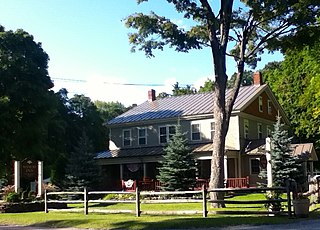
The Waybury Inn is an inn at 457 East Main Street in Middlebury, Vermont, United States. The inn was built in 1810, and is one of the oldest operating traveler's accommodations in the state. It was listed on the National Register of Historic Places in 1983. It is well known for its use in exterior shots of the Newhart television series.

The Hezekiah Chaffee House is a historic house museum on Meadow Lane in Windsor, Connecticut. Built about 1765, it is one of Windsor's largest and most elaborate Georgian brick houses. The house was listed on the National Register of Historic Places in 1972, and is a contributing property to the Palisado Avenue Historic District, listed in 1987. It is owned and operated by the Windsor Historic Society, which offers tours on a year-round basis.
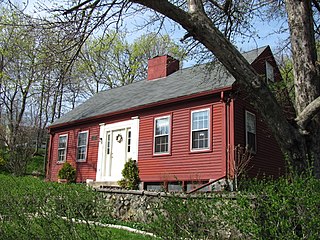
The John Wade House is a historic house located in Medford, Massachusetts. It is locally significant as one of only two surviving early Cape style houses in the city.

The Jonesborough Historic District is a historic district in Jonesborough, Tennessee, that was listed on the National Register of Historic Places as Jonesboro Historic District in 1969.
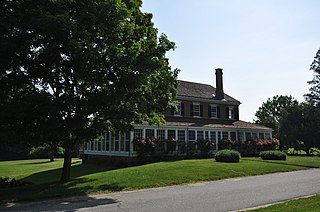
The Eastman Hill Rural Historic District is a historic district encompassing a rural landscape consisting of three 19th-century farmsteads near the village of Center Lovell, Maine. It covers 251 acres (102 ha) of the upper elevations of Eastman Hill, and is bisected by Eastman Hill Road. The area has been associated with the Eastman family since the early 19th century, and was one of the largest working farms in Lovell. Although the three properties were treated separately for some time, they were reunited in the early 20th century by Robert Eastman, a descendant of Phineas Eastman, the area's first settler. The district was listed on the National Register of Historic Places in 1993.

The Nathaniel and Elizabeth Bennett House, also locally known as the Cedarbrook Farm, is a historic house and farm property on the west side of Crockett Ridge Road in Norway, Maine, United States. The property is distinctive for its well-preserved Federal style house, including one room that contains an unusual form of stencil painting on its walls. It also has historic association with Don Carlos Seitz, the editor of the New York World, who operated a gentleman's farm on the property. It was listed on the National Register of Historic Places in 1996.
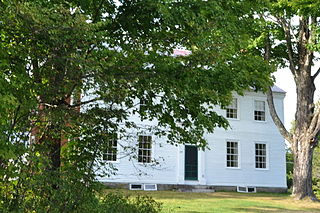
The Robinson-Parsons Farm is a historic farmhouse on Town Farm Brook Road in Paris, Maine. This house, a well-preserved Federal style structure whose oldest portion dates to c. 1795, was built by Stephen Robinson, one of the earliest white settlers of the area, and has remained in the hands of his descendants. It is regionally distinctive for its brick side walls, a feature not normally found in rural Maine. It was listed on the National Register of Historic Places in 1982.

The McCleary Farm is a historic farm complex on South Strong Road in Strong, Maine. Probably built sometime between 1825 and 1828, the main house is a fine local example of Federal style architecture. It is most notable, however, for the murals drawn on its walls by Jonathan Poor, an itinerant artist active in Maine in the 1830s. The property was listed on the National Register of Historic Places in 1989.
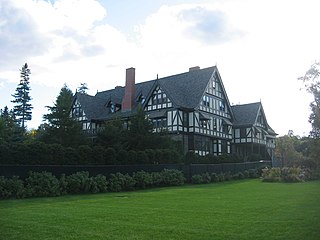
The John Innes Kane Cottage, also known as Breakwater and Atlantique, is a historic summer estate house at 45 Hancock Street in Bar Harbor, Maine. Built in 1903-04 for John Innes Kane, a wealthy grandson of John Jacob Astor and designed by local architect Fred L. Savage, it is one of a small number of estate houses to escape Bar Harbor's devastating 1947 fire. An imposing example of Tudor Revival architecture, it was listed on the National Register of Historic Places in 1992.

The William M. Shaw House is a historic house located at 40 Norris Street in Greenville, Maine, which now houses the Greenville Inn. Built in 1895, it is a handsome and elaborate example of Queen Anne architecture in a rural small-town setting. The house was designed by Edwin E. Lewis of Gardiner, with alterations by Wilfred E. Mansur of Bangor. The house was listed on the National Register of Historic Places in 2013 for its architecture, and for its association with William Shaw, a leading lumber businessman active in Greenville in the late 19th and early 20th centuries, whose business interests also included ownership of the steamer Katahdin.

The John Perkins House is a historic house museum on the grounds of the Wilson Museum at 120 Perkins Street in Castine, Maine. Built in 1765 on Court Street, it is one of the oldest houses in Castine, and a well-preserved example of Georgian architecture; it was moved to its present location in 1968-69 and restored. The house was listed on the National Register of Historic Places in 1969. It is open for tours on a limited basis during July and August; the Gallery located in the basement is open from May to September.
The Rockwell Kent Cottage and Studio are a pair of historic buildings associated with the artist Rockwell Kent on Monhegan Island off the coast of the United States state of Maine. Built in 1906 and 1910 by Kent, they are an important reminder of his presence on the island. Both properties were later owned by artist James E. Fitzgerald, and now serve as a museum displaying his works. They were listed on the National Register of Historic Places in 1992.

The Capt. Joel Whitney House is a historic house at 8 Pleasant Street in Phillips, Maine. Built in 1829 for a prominent early settler and businessman, it is one of the oldest houses in the small inland community, and probably the only two-story building of that age. It is now owned by the Phillips Historical Society, which houses museum displays in the rear sections. The house was listed on the National Register of Historic Places in 2003.

The Barrell Homestead is a historic house at 71 Beech Ridge Road in York, Maine, United States. At the core of this three-story house is a c. 1720 late First Period house, which has been in the hands of a single family since 1758. It was home to one of York's most colorful residents of the second half of the 18th century, Nathaniel Barrell. The house was listed on the National Register of Historic Places in 1976.
The Spaulding House is a historic house on Main Street in Norridgewock, Maine. Built about 1835 by one of the town's early settlers, it is a fine local example of Greek Revival executed in brick. The house was listed on the National Register of Historic Places in 1978.

The Farnsworth Homestead is a historic house museum at 21 Elm Street in Rockland, Maine. Built in 1854 by William A. Farnsworth, it is an excellent late example of Greek Revival architecture, and was the home of Lucy Farnsworth, the major benefactor of the Farnsworth Art Museum, which owns the house and operates it as a museum property. The house was listed on the National Register of Historic Places in 1973.

The Dutton-Small House is a historic house on Bog Road in Vassalboro, Maine. Built about 1825, it is one of the rural community's oldest buildings, and one of its only brick houses. It was listed on the National Register of Historic Places in 1990.
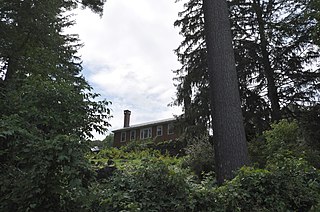
The Owen Moon Farm is a historic country estate on Morgan Hill Road in South Woodstock, Vermont. Set on a steeply sloped 8-acre (3.2 ha) parcel are its main house, an 1816 brick building, a barn, and a 1930s bungaloid guest house. The hilly terrain is heavily landscaped, forming an important visual component of the estate, and serving to afford it privacy from the nearby public roads. It was listed on the National Register of Historic Places in 1983, primarily for the well-preserved Federal period architecture of the main house.

The Aaron Jr. and Susan Parker Farm is a historic farm property at 1715 Brook Road in Cavendish, Vermont. Now just 16 acres (6.5 ha), the property includes a c. 1815 Federal style farmhouse, and a well-preserved early 19th century English barn. The farmstead was listed on the National Register of Historic Places in 2014.
The Kemp-Shepard House is a historic house on Highbridge Road in Georgia, Vermont. The main block of the brick house, built about 1830, is an important early work of a regional master builder, and it is attached to an older wood-frame ell. It was built on land that was among the first to be settled in the eastern part of the town. The house was listed on the National Register of Historic Places in 1997.


















